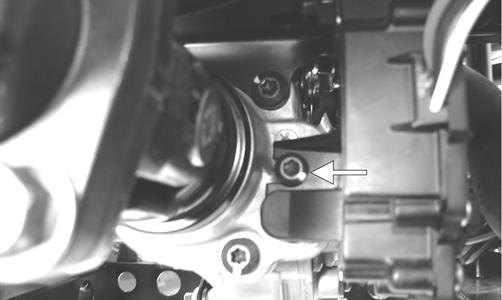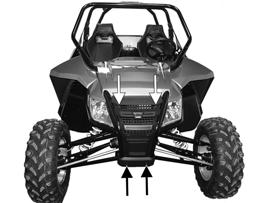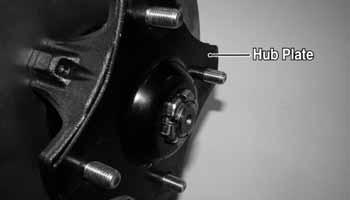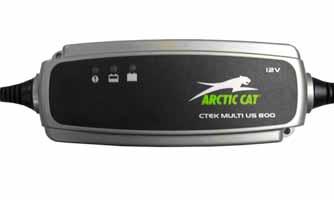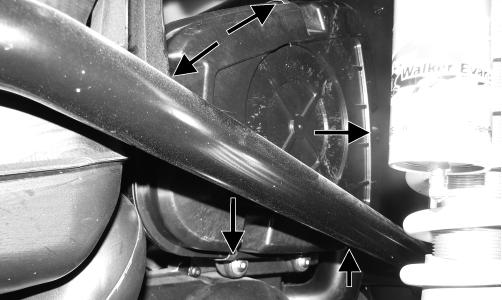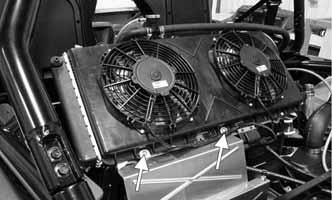
12 minute read
General Information
NOTE: Some photographs and illustrations used in
this manual are used for clarity purposes only and are not designed to depict actual conditions.
NOTE: Whenever a part is worn excessively,
cracked, or damaged in any way, replacement is necessary.
General Specifications
CHASSIS
Curb Weight (approx) 739 kg (1629 lb) ROPS Tested Curb Weight 1361 kg (3000 lb) Length (overall) 378.5 cm (149 in.) Height (overall) 167.0 cm (65.8 in.) Width (overall) 162.6 cm (64 in.) Suspension Travel (Front) 43.2 cm (17 in.) (Rear) 45.4 cm (18 in.) Brake Type Hydraulic Disc (Four-Wheel) Tire Size 26 x 9R14 (front) 26 x 11R14 (rear) Tire Inflation Pressure 1.12 kg/cm² (16 psi)
MISCELLANY
Spark Plug Type NGK CPR8E Spark Plug Gap 0.5-0.6 mm (0.019-0.024 in.) Gas Tank Capacity 33.3 L (8.8 U.S. gal.) Coolant Capacity 3.3 L (3.5 U.S. qt) Front Differential Capacity 200 ml (6.7 fl oz)* Rear Drive Capacity 175 ml (5.9 fl oz)* Engine Oil Capacity 2.8 L (3.0 U.S. qt) - Overhaul 2.3 L (2.4 U.S. qt) - Change Gasoline (recommended) 87 Octane Regular Unleaded Engine Oil (recommended) Arctic Cat ACX All Weather Synthetic Front Differential/Rear Drive Lubricant SAE Approved 80W-90 Hypoid Belt Width 35.0 mm (1.38 in.) Brake Fluid DOT 4 Taillight/Brakelight High Intensity LED Headlight High Intensity LED
ELECTRICAL SYSTEM
Spark Plug Cap 5000 ohms Ignition Coil (primary) Less than 1 ohm Resistance (terminal (+) to ground (-)) (secondary) 1.8M ohms (high tension - plug cap removed to either primary terminal (+)) Ignition Coil Primary Voltage Battery Voltage (orange (+) to ground)
Stator Coil Resistance (crankshaft position sensor) 150-250 ohms (brown/white to green/white) (AC generator) Less than 1 ohm (brown/ white to green/white) Crankshaft Position Sensor AC Voltage 2.0 or more (brown/white to green/white) AC Generator Output (no load)75 AC volts @ 5000 RPM (black to black) Ignition Timing 10° BTDC @ 1500 RPM
VALVES AND GUIDES
Valve Face Diameter (intake) 31.6mm (exhaust) 27.9mm Valve/Tappet Clearance (intake) 0.1016 mm (cold engine) (max) (exhaust) 0.1524 mm Valve Guide/Stem Clearance (max)0.013mm Valve Guide/Valve Stem Deflection (max) 0.35mm (wobble method) Valve Guide Inside Diameter 5.000-5.012mm Valve Stem Outside Diameter 4.972-4.987mm Valve Stem Runout (max)0.1mm Valve Head Thickness (min)2.3mm Valve Face/Seat Width (intake) 2.25mm (exhaust) 2.60 mm Valve Seat Angle 45° +15’/+30’ Valve Face Radial Runout (max)0.2mm Valve Spring Free Length (min)38.7mm Valve Spring Tension @ 31.5mm 19.0 kg (42 lb)
CAMSHAFT AND CYLINDER HEAD
Cam Lobe Height (min)33.53mm Camshaft Journal Oil Clearance (max)0.04mm Camshaft Journal Holder (right & center) 21.98-22.04 mm Inside Diameter (left) 17.48-17.53 mm Camshaft Journal Outside(right & center) 21.96-21.98 mm Diameter (left) 17.48-17.53 mm Camshaft Runout (max)0.05 mm Rocker Arm Inside Diameter (max)12.018 mm Rocker Arm Shaft Outside Diameter (min)11.97 mm Cylinder Head/Cover Distortion (max)0.05 mm
CYLINDER, PISTON, AND RINGS
Piston Skirt/Cylinder Clearance 0.05mm Cylinder Bore 91.992-92.008 mm Piston Diameter 15mm from Skirt End 91.949-91.959mm Piston Ring Free End Gap (min)(1st/2nd)12.5 mm Bore x Stroke 92 x 71.6 mm Cylinder Trueness (max)0.075mm Piston Ring End Gap - Installed 0.38mm Piston Ring to Groove Clearance 1st 0.034mm (max) (2nd) 0.033mm Piston Ring Groove Width (1st/2nd) 1.202-1.204mm (oil) 2.501-2.503mm Piston Ring Thickness (1st/2nd)1.170-1.195mm Piston Pin Bore (max)20.012mm Piston Pin Outside Diameter (min)19.995mm
CRANKSHAFT
Connecting Rod (max) 20.021mm (small end inside diameter) Connecting Rod (big end side-to-side) 0.95mm Connecting Rod (max) 0.3mm (small end deflection) Crankshaft (web-to-web) 98mm Crankshaft Runout (max)0.03mm Oil Pump Gerotor Clearance (max)0.15 mm
Specifications subject to change without notice.
Torque Specifications
NOTE: Torque specifications have the following tolerances:
Torque (ft-lb) Tolerance
0-15 ±20% 16-39 ±15% 40+ ±10%
EXHAUST COMPONENTS
Part Part Bolted To Torque ft-lb N-m
Exhaust Pipe Cylinder Head Spark Arrester Muffler
BRAKE COMPONENTS
Brake Disc** Hub
20 27 72 in.-lb 8
15 20 Brake Hose Caliper 20 27 Brake Hose Master Cylinder 20 27 Master Cylinder Frame 25 34 Caliper Holder (Rear)**** Knuckle 20 27 Front Brake Caliper Knuckle 35 48
SUSPENSION COMPONENTS (Front)
A-Arm Frame 40 54 Knuckle**** Ball Joint 35 48 Shock Absorber Frame/Lower A-Arm 40 54
SUSPENSION COMPONENTS (Rear)
Sway Bar Mount Frame 40 54 Sway Bar Link Sway Bar Arm 35 48 Sway Bar Link Lower Trailing Arm 35 48 Seat Belt Retractor Frame 60 81 Seat Belt Flange Frame 60 81 Seat Belt Buckle Anchor Frame 60 81 Shoulder Anchor ROPS Hoop 35 48 Lower Trailing Arm Lower Trailing Arm Cross 60 81 Mount (min) Upper Trailing Arm Frame 35 48 Shock Absorber (Lower) Trailing Arm 35 48 Shock Absorber (Upper) Frame 40 54 Knuckle Lower Trailing Arm 60 81 Knuckle Upper Trailing Arm 35 48 Upper/Lower Lateral Link Knuckle 40 54 Upper/Lower Lateral Link Frame 40 54 Cargo Box Cargo Box Support 72 8 in.-lb
CHASSIS/ROPS ASSEMBLY
Shift Lever* Shift Axle Bracket 20 27 Shift Cable Shift Arm 8 11 Front ROPS Tube Frame 35 48 Center ROPS Support Front/Rear ROPS Tubes 35 48 Rear ROPS Tube Lower ROPS Support 35 48
STEERING COMPONENTS
Steering Wheel** Steering Wheel Shaft 25 34 Rack and Pinion Bracket Frame 20 27 Rack and Pinion Assembly Frame 25 34 Tie Rod** Rack 55 75 Tie Rod End** Knuckle 55 74 Jam Nut Tie Rod End 10 14 Steering Flex-Shaft Hold-Down Housing 50 5.5 Strap in.-lb Tilt-Steering Link Frame 10 14 EPS Mounting Bracket EPS 35 48 EPS Assembly Frame 20 27 Steering Shaft Upper Collar Tilt Assembly 20 27 Steering Shaft Lower U-Clamp Frame 7 9
Rear Drive/Gear Case Frame
38 48 Drive Coupler Propeller Shaft 40 54 Driveline Coupler Front Engine Flange 20 27 Front Differential Frame/Differential Bracket 38 52 Carrier Bearing Bracket 38 54 Carrier Bearing Support Bracket Frame 20 27 Input Shaft Assembly Gear Case Housing 23 31 Secondary Drive Gear Nut Secondary Drive Gear 4 6 Pinion Housing Differential Housing 23 31 Thrust Button** Gear Case Cover 8 11 Differential Housing Cover*** Differential Housing 23 31 Drive Bevel Gear Nut*** Shaft 87 118 Lock Collar Differential Housing 125 170 Hub Nut***** Front/Rear Shaft/Axle (min) 250 340 Oil Drain Plug Front Differential - Rear Drive 45 5 in.-lb Oil Fill/Level Plug Front Differential - Rear Drive 16 22 Oil Drain Plug Engine 16 22 Wheel Hub (20 ft-lb increments) 80 108
ENGINE/TRANSMISSION
Front Engine Through-Bolt Frame 40 54 Rear Engine Through-Bolt Frame 40 54 Drive Clutch Spider Fixed Driven Hub 221 300 Clutch Cover/Housing Assembly Crankcase 8 11 Lower Crankcase Cover (6 mm) Crankcase 8 11 Lower Crankcase Cover (8 mm) Crankcase 20 27 Crankcase Half Crankcase Half 8 11 Cylinder Head (Cap Screw) Crankcase 38 52 Cylinder Head Nut (6 mm) Cylinder 8 11 Cylinder Head Nut (8 mm) Cylinder 18 24 Valve Cover Cylinder Head 8.5 11.5 Driven Pulley Cap Screw Driveshaft 60 81 Drive Clutch Cap Screw Crankshaft 60 81 Ground Wire Engine 8 11 Magneto Cover Crankcase 112 12.5 in.-lb
Tappet Cover Valve Cover Drive Clutch Cover Fixed Post
9 12 112 in.-lb 12.6
Oil Pump Drive Gear** Crank Balancer Shaft 62 84 Output Flange Nut** Output Shaft 150 204 Outer Magneto Cover Magneto Cover 8 11 Rotor/Flywheel Nut** Crankshaft 105 143 Cam Sprocket** Camshaft 11 15 CVT Cover Crankcase 8 11 Secondary Drive Gear Nut** Secondary Drive Output Shaft 200 270 Oil Filter Cover Crankcase 8 11 Speed Sensor Housing Crankcase 8 11 Shift Cam Stopper Crankcase 8 11 Shift Cam Stopper Spring Shift Cam Stopper 8 11 Shift Cam Plate Shift Cam Shaft 8 11 Shifter Housing Crankcase 8 11 Starter Motor Crankcase 8 11 V-Belt Cover Crankcase 8 11 Oil Pump Cover* Crankcase 8 11 Oil Strainer Cap Crankcase 8 11 Intake Boot Clamp Intake Boot 30 3.4 in.-lb
Starter One-Way Clutch** Rotor/Flywheel 26 35
Fuel Rail Engine Air Filter Housing Engine
ELECTRICAL COMPONENTS
Ground Wire Engine * w/Blue Loctite #243 *** w/Green Loctite #270 ** w/Red Loctite #271 **** w/“Patch-Lock” *****w/Primer #7649 and Loctite #277
6 8 6 8
8 11
Torque Conversions (ft-lb/N-m)
Break-In Procedure
ft-lb N-m ft-lb N-m ft-lb N-m ft-lb N-m 1 1.4 26 35.4 51 69.4 76 103.4 2 2.7 27 36.7 52 70.7 77 104.7 3 4.1 28 38.1 53 72.1 78 106.1 4 5.4 29 39.4 54 73.4 79 107.4 5 6.8 30 40.8 55 74.8 80 108.8 6 8.2 31 42.2 56 76.2 81 110.2 7 9.5 32 43.5 57 77.5 82 111.5 8 10.9 33 44.9 58 78.9 83 112.9 9 12.2 34 46.2 59 80.2 84 114.2 10 13.6 35 47.6 60 81.6 85 115.6 11 15 36 49 61 83 86 117 12 16.3 37 50.3 62 84.3 87 118.3 13 17.7 38 51.7 63 85.7 88 119.7 14 19 39 53 64 87 89 121 15 20.4 40 54.4 65 88.4 90 122.4 16 21.8 41 55.8 66 89.8 91 123.8 17 23.1 42 57.1 67 91.1 92 125.1 18 24.5 43 58.5 68 92.5 93 126.5 19 25.8 44 59.8 69 93.8 94 127.8 20 27.2 45 61.2 70 95.2 95 129.2 21 28.6 46 62.6 71 96.6 96 130.6 22 29.9 47 63.9 72 97.9 97 131.9 23 31.3 48 65.3 73 99.3 98 133.3 24 32.6 49 66.6 74 100.6 99 134.6 25 34 50 68 75 102 100 136
A new vehicle and an overhauled engine require a “breakin” period. The first 10 hours (or 200 miles) are most critical to the life of this vehicle. Proper operation during this break-in period will help assure maximum life and performance from the vehicle. During the first 10 hours (or 200 miles) of operation, always use less than 1/2 throttle. Varying the engine RPM during the break-in period allows the components to “load” (aiding the mating process) and then “unload” (allowing components to cool). Although it is essential to place some stress on the engine components during breakin, care should be taken not to overload the engine too often. Do not pull a trailer or carry heavy loads during the 10-hour break-in period. When the engine starts, allow it to warm up properly. Idle the engine several minutes until the engine has reached normal operating temperature. Do not idle the engine for excessively long periods of time. During the break-in period, a maximum of 1/2 throttle is recommended; however, brief full-throttle accelerations and variations in driving speeds contribute to good engine break-in. After the completion of the break-in period, the engine oil and oil filter should be changed. Other maintenance after break-in should include checking of all prescribed adjustments and tightening of all fasteners (see Periodic Maintenance Chart in Periodic Maintenance/Tune-Up).
Gasoline - Oil - Lubricant
RECOMMENDED GASOLINE The recommended gasoline to use is 87 minimum octane regular unleaded. In many areas, oxygenates are added to the gasoline. Oxygenated gasolines containing up to 10% ethanol or 5% methane are acceptable gasolines. When using ethanol blended gasoline, it is not necessary to add a gasoline antifreeze since ethanol will prevent the accumulation of moisture in the fuel system.
RECOMMENDED ENGINE/ TRANSMISSION OIL The recommended oil to use is Arctic Cat ACX All Weather synthetic engine oil, which has been specifically formulated for use in this Arctic Cat engine. Although Arctic Cat ACX All Weather synthetic engine oil is the only oil recommended for use in this engine, use of any API certified SM 0W-40 oil is acceptable.
CAUTION
Do not use white gas. Only Arctic Cat approved gasoline additives should be used.
OILCHARTJ
RECOMMENDED FRONT DIFFERENTIAL/REAR DRIVE LUBRICANT The recommended lubricant is Arctic Cat Gear Lube or an equivalent gear lube which is SAE approved 80W-90 hypoid. This lubricant meets all of the lubrication requirements of the Arctic Cat vehicle front differential and rear drive.
CAUTION
Any lubricant used in place of the recommended lubricant could cause serious front differential/rear drive damage.
FILLING GAS TANK ! WARNING
Always fill the gas tank in a well-ventilated area. Never add fuel to the gas tank near any open flames or with the engine running. DO NOT SMOKE while filling the gas tank.
ATV0049B
Since gasoline expands as its temperature rises, the gas tank must be filled to its specified capacity only. Expansion room must be maintained in the tank particularly if the tank is filled with cold gasoline and then moved to a warm area.
Tighten the gas tank cap securely after filling the tank.
! WARNING
Do not overflow gasoline when filling the gas tank. A fire hazard could materialize. Always allow the engine to cool before filling the gas tank.
! WARNING
Do not over-fill the gas tank.
Genuine Parts
When replacement of parts is necessary, use only genuine Arctic Cat parts. They are precision-made to ensure high quality and correct fit. Refer to the appropriate Illustrated Parts Manual for the correct part number, quantity, and description.
Preparation For Storage
CAUTION
Prior to storing the vehicle, it must be properly serviced to prevent rusting and component deterioration.
1.Clean the seat cushion (cover and base) with a damp cloth and allow it to dry. 2.Clean the vehicle thoroughly by washing dirt, oil, grass, and other foreign matter from the entire vehicle.
Allow it to dry thoroughly. DO NOT get water into any part of the engine or air intake. 3.Either drain the gas tank or add Fuel Stabilizer to the gas in the gas tank. Remove the air filter housing cover and air filter. Start the engine and allow it to idle. Using Arctic Cat
Engine Storage Preserver, rapidly inject the preserver into the air filter opening for a period of 10 to 20 seconds; then stop the engine. Install the air filter and housing cover.
CAUTION
If the interior of the air filter housing is dirty, clean the area before starting the engine.
4.Plug the exhaust hole in the exhaust system with a clean cloth. 5.Apply light oil to the plungers of the shock absorbers. 6.Tighten all nuts, bolts, cap screws, and screws. Make sure rivets holding components together are tight. Replace all loose rivets. Care must be taken that all calibrated nuts, cap screws, and bolts are tightened to specifications. 7.Fill the cooling system to the bottom of the stand pipe in the radiator neck with properly mixed coolant. 8.Disconnect the battery cables; then remove the battery, clean the battery posts and cables, and store in a clean, dry area. 9.Store the vehicle indoors in a level position.
CAUTION
Avoid storing outside in direct sunlight and avoid using a plastic cover as moisture will collect on the vehicle causing rusting.
Preparation After Storage
Taking the vehicle out of storage and correctly preparing it will assure many miles and hours of trouble-free riding. 1.Clean the vehicle thoroughly. 2.Clean the engine. Remove the cloth from the exhaust system. 3.Check all control wires and cables for signs of wear or fraying. Replace if necessary. 4.Change the engine/transmission oil and filter. 5.Check the coolant level and add properly mixed coolant as necessary. 6.Charge the battery; then install. Connect the battery cables.
7.Check the entire brake systems (fluid level, pads, etc.), all controls, headlights, taillight, brakelight, and headlight aim; adjust or replace as necessary. 8.Tighten all nuts, bolts, cap screws, and screws making sure all calibrated nuts, cap screws, and bolts are tightened to specifications. 9.Check tire pressure. Inflate to recommended pressure as necessary. 10.Make sure the steering moves freely and does not bind. 11.Check the spark plugs. Clean or replace as necessary.
CAUTION
The ignition switch must be in the OFF position prior to installing the battery or damage may occur to the ignition system.
CAUTION

